2023 Reports 1 to 4 of the Auditor General of Canada to the Parliament of Canada
Report 4—International Assistance in Support of Gender Equality—Global Affairs Canada
At a Glance
Overall, Global Affairs Canada was unable to show how the approximately $3.5 billion in bilateral development assistance it provides each year to low‑and middle‑income countries improved outcomes for women and girls. When women and girls have equal opportunities to succeed, they can be powerful agents of change—driving economic growth and improving the quality of life for their families and their communities.
Significant weaknesses in the department’s information management practices resulted in incomplete or missing project files that do not support tracking overall outcomes against policy goals. In addition, 24 of the 26 indicators the department had created to monitor progress against policy goals did not measure outcomes. This makes it impossible for the department to accurately account for the outcomes of funded projects. In addition, annual reports to Parliament on international assistance captured outputs for only around half of the funded projects and do not reflect long-term outcomes.
The department’s poor information management practices, which were flagged in a departmental audit in 2021, also had an impact on our audit work, as there were delays in receiving documents from Global Affairs Canada.
It is imperative that Global Affairs Canada act immediately to improve its information management and reporting on outcomes to demonstrate that women and girls are benefitting from the programs that Canada is funding and that there is value in Canada’s investments.
Why we did this audit
- Supporting gender equality and the empowerment of women and girls is consistent with values promoted by the Government of Canada, such as global citizenship, equity, environmental sustainability, human rights, and ethnic and cultural diversity.
- Canadians and Parliament expect Global Affairs Canada to demonstrate that the implementation of Canada’s Feminist International Assistance Policy has improved the circumstances of people who would benefit most from the international assistance that Canada provides.
Key findings
- There were significant weaknesses in the way the department managed project information. Global Affairs Canada was not effectively monitoring its funded projects or reporting on them.
- The annual reports to Parliament on international assistance captured outputs for only around half of Global Affairs Canada’s funded projects. This was insufficient to accurately reflect outcomes.
- Global Affairs Canada did not meet 2 out of 3 of Canada’s Feminist International Assistance Policy spending commitments.
Key facts and figures
- Canada’s Feminist International Assistance Policy, launched in 2017, included 3 commitments for how this international assistance should be spent.
- There were no commitments related to outcomes in the policy.
- Global Affairs Canada administered an average of $3.5 billion per year for bilateral development assistance programming from 1 April 2017 to 31 March 2022.
Highlights of our recommendations
- Global Affairs Canada should take immediate action to invest in its information management systems and practices, including relevant training, so that the department has a comprehensive and reliable approach for storing, retrieving, and using its project information.
- Global Affairs Canada should consider identity factors beyond gender and age in its project-level gender equality assessments to support more inclusive programming.
Please see the full report to read our complete findings, analysis, recommendations and the audited organizations’ responses.
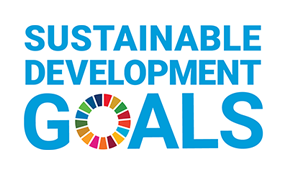


In 2015, Canada adopted the United Nations’ 2030 Agenda for Sustainable Development and committed to advancing the United Nations’ Sustainable Development Goals in Canada and abroad. Progress against many of these goals is advanced by international assistance activities. The department mapped the policy indicators to the related Sustainable Development Goals so that it could measure project contributions toward each goal. Specifically, Goal 1 relates to poverty reduction and Goal 5 relates to gender equality.
Because the department was not using its policy indicators to capture outcomes for many of the projects, it was also not tracking contributions to Sustainable Development Goals. As a result, the department missed an opportunity to demonstrate the value of international assistance.
Visit our Sustainable Development page to learn more about sustainable development and the Office of the Auditor General of CanadaOAG.
Exhibit highlights
Total bilateral development assistance to low- and middle-income countries from the 2017–18 to the 2021–22 fiscal years
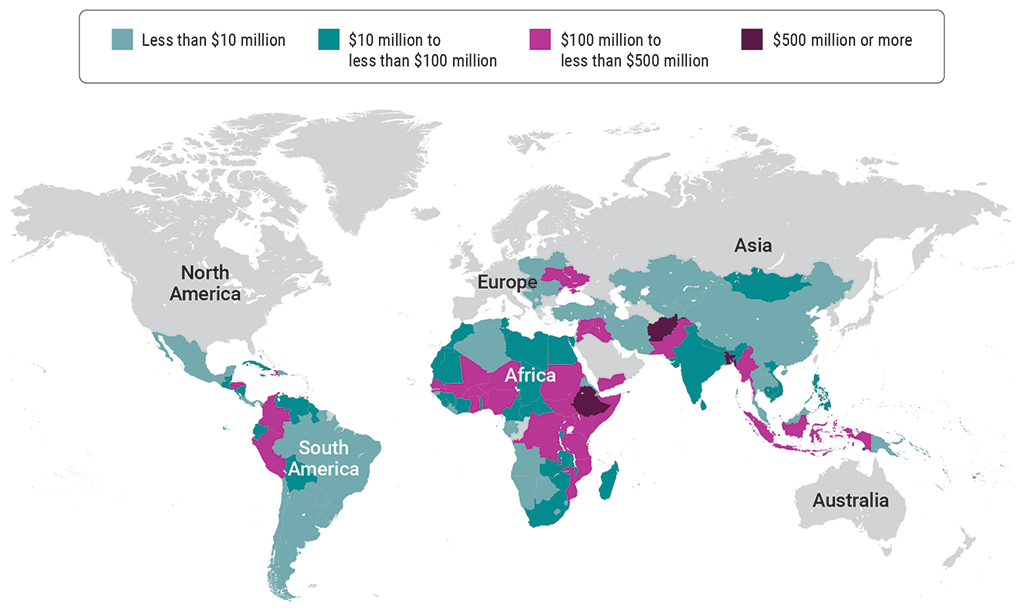
Source: Based on data from Global Affairs Canada
Text version
This world map shows the low- and middle-income countries that received bilateral development assistance from the 2017–18 to the 2021–22 fiscal years. The countries are organized into 4 categories, according to the total amount of assistance they received: less than $10 million, $10 million to less than $100 million, $100 million to less than $500 million, and $500 million or more.
The following list of countries and the amounts they received are in descending order so that the countries that received the most are listed first and the countries that received the least are listed last.
The following countries received $500 million or more:
- Afghanistan
- Bangladesh
- Ethiopia
The following countries received from $100 million to less than $500 million:
- Benin
- Burkina-Faso
- Caribbean
- Colombia
- Democratic Republic of the Congo
- Ghana
- Haiti
- Honduras
- Indonesia
- Iraq
- Jordan
- Kenya
- Lebanon
- Mali
- Mozambique
- Myanmar
- Niger
- Nigeria
- Pakistan
- Peru
- Senegal
- Somalia
- South Sudan
- Sudan
- Syria
- Tanzania
- Uganda
- Ukraine
- West Bank
- Yemen
The following countries received from $10 million to less than $100 million:
- Belize
- Bolivia
- Burundi
- Cambodia
- Cameroon
- Central African Republic
- Chad
- Côte d'Ivoire
- Cuba
- Dominica
- Ecuador
- Egypt
- El Salvador
- Grenada
- Guatemala
- Guinea
- Guyana
- India
- Jamaica
- Libya
- Madagascar
- Malawi
- Mauritania
- Mongolia
- Morocco
- Nepal
- Nicaragua
- Philippines
- Rwanda
- Sierra Leone
- South Africa
- Sri Lanka
- St. Lucia
- Togo
- Tunisia
- Venezuela
- Vietnam
- Zambia
- Zimbabwe
The following countries received less than $10 million:
- Albania
- Algeria
- Angola
- Anguilla
- Antigua and Barbuda
- Argentina
- Armenia
- Azerbaijan
- Bahamas
- Barbados
- Belarus
- Bhutan
- Bosnia-Herzegovina
- Botswana
- Brazil
- British Virgin Islands
- Cape Verde
- Central Africa
- Central Asia
- Chile
- China
- Comoros
- Congo-Brazzaville
- Costa Rica
- Djibouti
- Dominican Republic
- Equatorial Guinea
- Eritrea
- Fiji
- Gabon
- Gambia
- Georgia
- Guinea-Bissau
- Hungary
- Iran
- Kazakhstan
- Kiribati
- Democratic People’s Republic of Korea
- Kyrgyzstan
- Laos
- Lesotho
- Liberia
- Malaysia
- Maldives
- Marshall Islands
- Mauritius
- Mexico
- Micronesia
- Moldova
- Montenegro
- Montserrat
- Namibia
- Nauru
- North Macedonia
- Palau
- Panama
- Papua New Guinea
- Paraguay
- Poland
- Romania
- São Tomé and Príncipe
- Serbia
- Seychelles
- Slovakia
- Solomon Islands
- Saint Kitts and Nevis
- St. Vincent
- Suriname
- Swaziland
- Tajikistan
- Thailand
- Timor-Leste
- Trinidad and Tobago
- Turkey
- Uruguay
- Uzbekistan
- Vanuatu
- Western Samoa
Global Affairs Canada did not provide all required documents
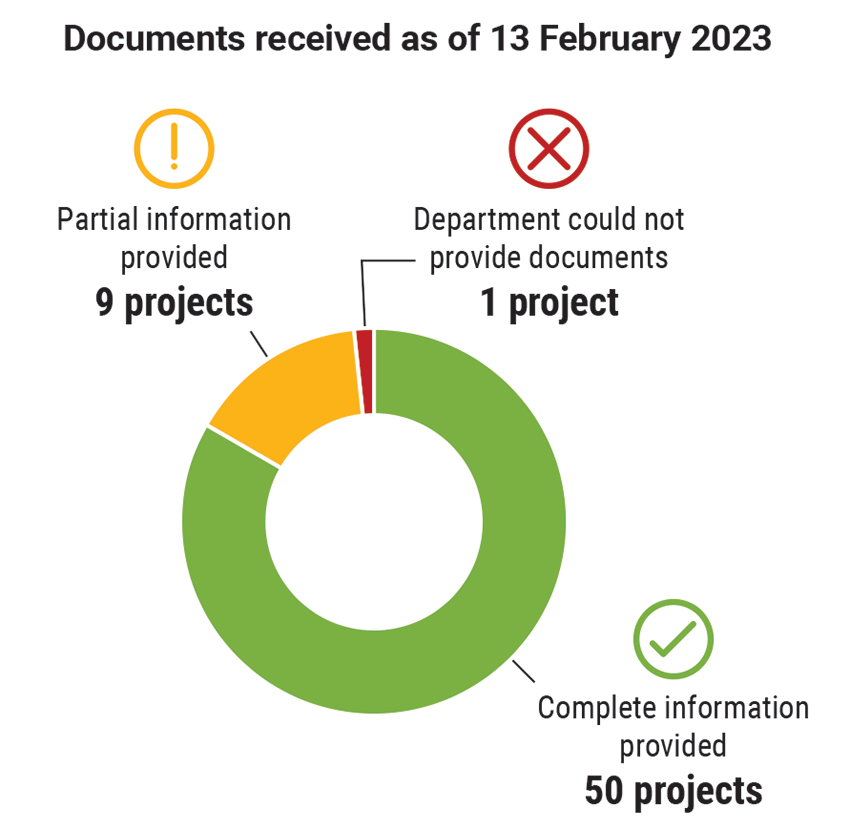
Text version
This pie chart shows the number of projects for which the audit team received complete, partial, or no information as of 13 February 2023.
Complete information was provided for 50 projects.
Partial information was provided for 9 projects.
The department could not provide documents for 1 project.
Canada’s Feminist International Assistance Policy established 3 annual commitments for bilateral spending in 2 project categories
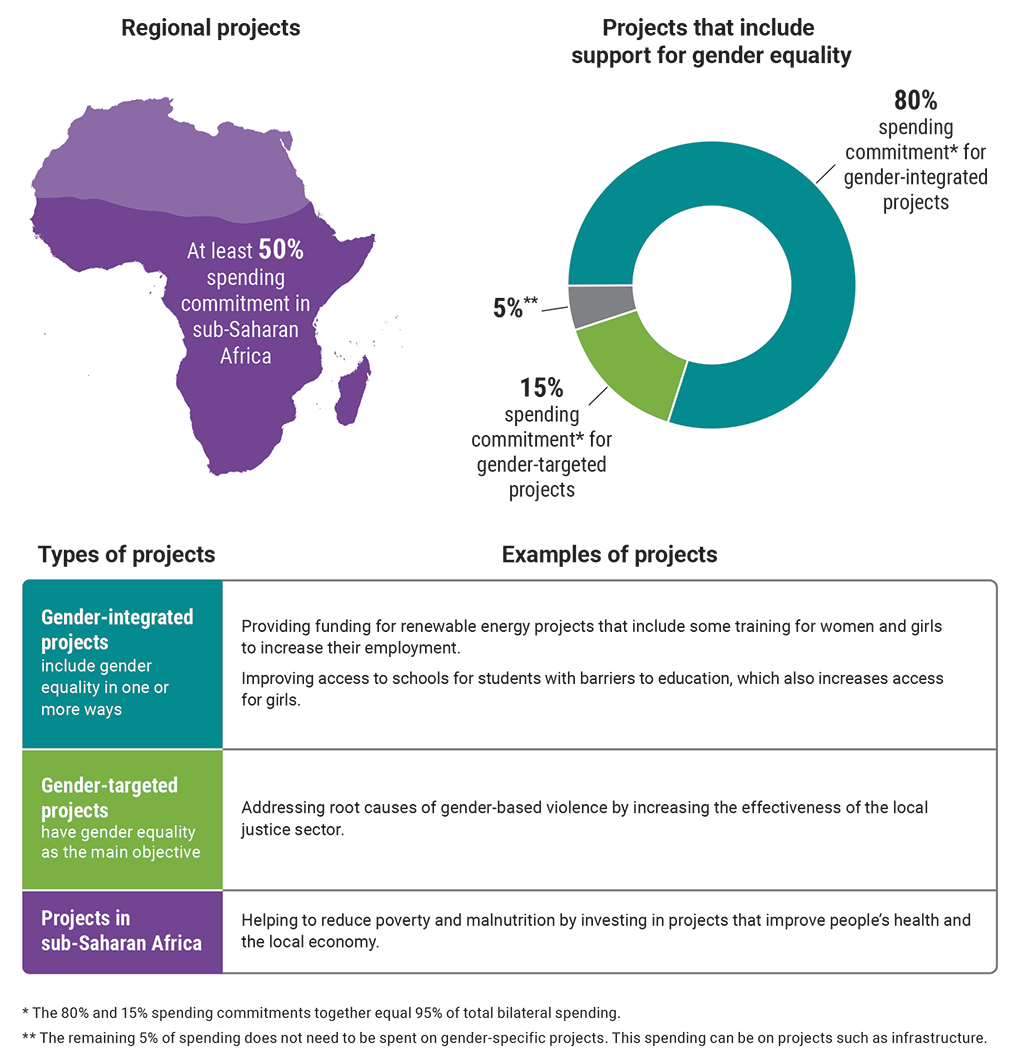
Source: Adapted from Canada’s Feminist International Assistance Policy, Global Affairs Canada
Text version
Canada’s Feminist International Assistance Policy included 3 commitments in 2 project categories for bilateral spending. Two images show the policy’s 2 categories of projects:
- The first image is the African continent showing the regional commitment of at least 50% of spending for projects in sub‑Saharan Africa.
- The second image is a donut chart that shows commitments for projects that include support for gender equality. The spending commitments are as follows: at least 80% for gender-integrated projects and at least 15% for gender-targeted projects. The 80% and 15% spending commitments together equal 95% of total bilateral development spending.
The remaining 5% of spending does not need to be spent on gender-specific projects. This spending can be on projects such as infrastructure.
The following are 2 examples of gender-integrated projects, which include gender equality in one or more ways:
- providing funding for renewable energy projects that include some training for women and girls to increase their employment
- improving access to schools for students with barriers to education, which also increases access for girls
The following is an example of a gender-targeted project, which has gender equality as the main objective:
- addressing root causes of gender-based violence by increasing the effectiveness of the local justice sector
The following is an example of a project in sub‑Saharan Africa:
- helping to reduce poverty and malnutrition by investing in projects that improve people’s health and the local economy
Global Affairs Canada missed 2 spending commitments but increased the proportion of spending for gender-targeted projects

Source: Based on financial data from Global Affairs Canada
Text version
These 3 charts compare the spending commitments and actual percentage of spending for gender-integrated projects, gender-targeted projects, and projects in sub‑Saharan Africa by fiscal year from 2016–17 to 2021–22. The amounts spent in the 2016–17 fiscal year were before Canada’s Feminist International Assistance Policy was implemented.
In 2017–18, the department committed 80% of bilateral funding for gender-integrated projects. The actual percentage of spending in each fiscal year was as follows:
- 86% in 2016–17, before Canada’s Feminist International Assistance Policy was implemented
- 89% in 2017–18
- 90% in 2018–19
- 83% in 2019–20
- 81% in 2020–21
- 89% in 2021–22
In 2017–18, the department committed 15% of bilateral funding for gender-targeted projects. The actual percentage of spending in each fiscal year was as follows:
- 2% in 2016–17, before the policy was implemented
- 3% in 2017–18
- 6% in 2018–19
- 14% in 2019–20
- 12% in 2020–21
- 10% in 2021–22
In 2017–18, the department committed 50% of bilateral funding for projects in sub‑Saharan Africa. The actual percentage of spending in each fiscal year was as follows:
- 35% in 2016–17, before the policy was implemented
- 49% in 2017–18
- 45% in 2018–19
- 42% in 2019–20
- 47% in 2020–21
- 48% in 2021–22
The following is the total departmental spending on bilateral projects:
- $1.3 billion in 2016–17, before the policy was implemented
- $2.7 billion in 2017–18
- $2.9 billion in 2018–19
- $3.1 billion in 2019–20
- $5.2 billion in 2020–21
- $3.8 billion in 2021–22
The amount spent in the 2020–21 and 2021–22 fiscal years includes $2.5 billion in COVID‑19 funding.
Infographic
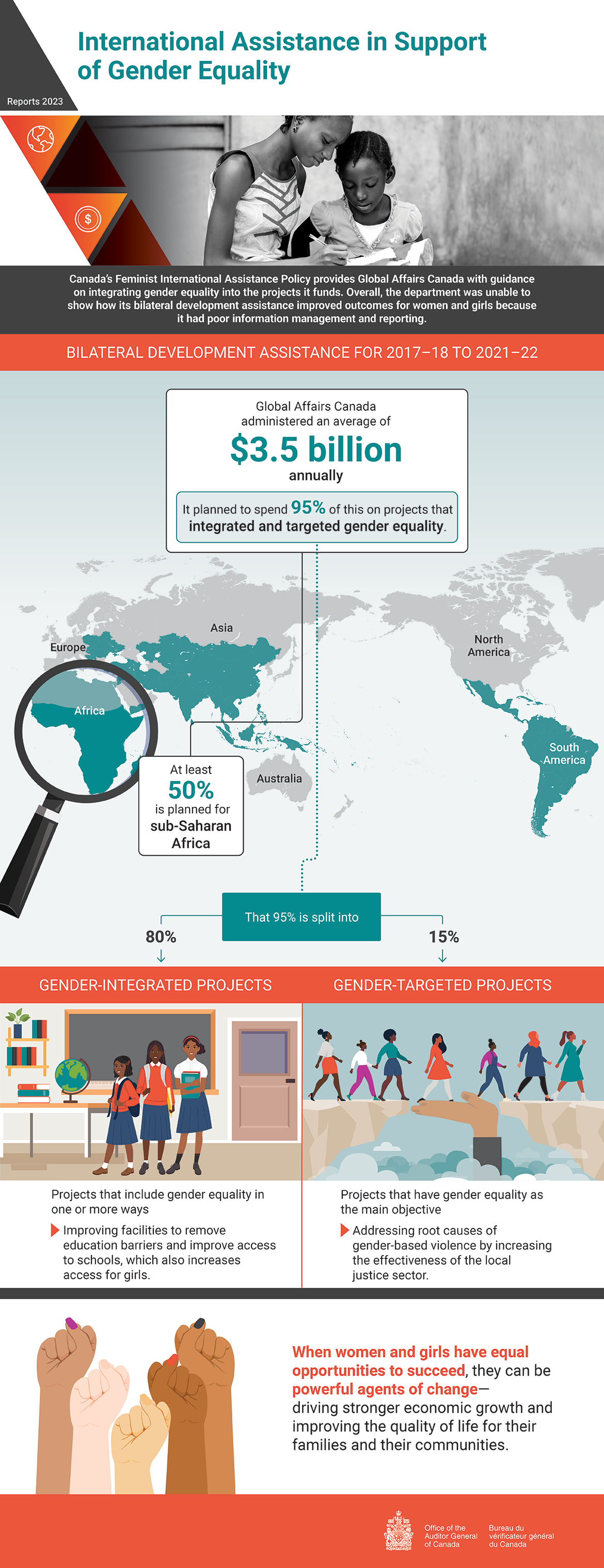
Text version
International Assistance in Support of Gender Equality
Canada’s Feminist International Assistance Policy provides Global Affairs Canada with guidance on integrating gender equality into the projects it funds. Overall, the department was unable to show how its bilateral development assistance improved outcomes for women and girls because it had poor information management and reporting.
Bilateral development assistance for 2017–18 to 2021–22
Global Affairs Canada administered an average of $3.5 billion annually. It planned to spend 95% of this on projects that integrated and targeted gender equality.
At least 50% of funding is planned for sub-Saharan Africa. This area of Africa is highlighted on the world map.
The 95% of funding is split into 80% for gender-integrated projects and 15% for gender-targeted projects.
Gender-integrated projects include gender equality in one or more ways—for example, improving facilities to remove education barriers and improve access to schools, which also increases access for girls.
Gender-targeted projects have gender equality as the main objective—for example, addressing root causes of gender-based violence by increasing the effectiveness of the local justice sector.
When women and girls have equal opportunities to succeed, they can be powerful agents of change—driving stronger economic growth and improving the quality of life for their families and their communities.
Related information
Entities
Tabling date
- 27 March 2023
Related audits
- 2018 Reports of the Commissioner of the Environment and Sustainable Development to the Parliament of Canada
Report 2—Canada’s Preparedness to Implement the United Nations Sustainable Development Goals - 2014 Fall Report of the Auditor General of Canada
Chapter 1—Responding to the Onset of International Humanitarian Crises
Parliamentary hearings
